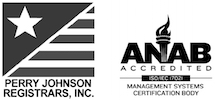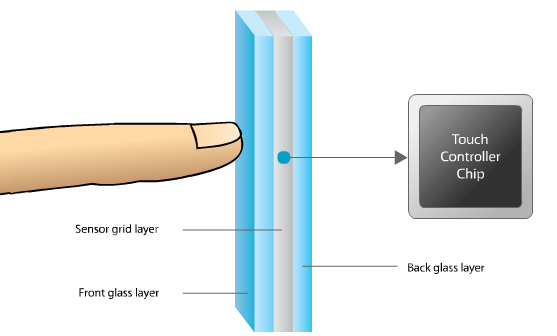Understanding Multi-Touch Projected Capacitive Technology
Capacitive sensing in touch screens has been around since the 1970s, but with the recent explosion in popularity of the smartphone, Multi-Touch Projected Capacitive technology has come to the forefront of touch screen technology. A projected capacitive type multi-touch screen is a touch user interface that allows users to interact with the device with the touch of a finger. The multi-touch feature enables users to tap the display, swipe across the screen, and zoom in and out.
How does Multi-Touch Technology work?
Projected capacitive touch screens have front and back protective glass providing optical and strength enhancement options. Its middle layer consists of a laminated sensor grid of micro-fine wires and optical enhancement options.
During a touch, capacitance forms between the finger and the sensor grid. The embedded serial controller in the touchscreen calculates touch location coordinates and transmits them to the computer for processing.
Why Use Projected Capacitive Touch Screen?
Superior Optical Clarity
Projected capacitive touch panels made with all-glass construction, which have near 100% optical clarity, makes them ideal for incorporating touch interactivity into demanding medical applications that require high-end LCDs with superior contrast, resolution, luminance, and sharpness.
Extreme Durability
Because the top layer is glass, a projected capacitive touch screen is extremely durable. It won’t deform over time or shrink from exposure to heat, and the glass can be cleaned without damaging the touch screen or decreasing its optical clarity. When assembled into a sealed enclosure, a projected capacitive touch screen can function normally even after being fully immersed in a liquid, sprayed with corrosive chemicals or struck with a hammer. As long as the top layer of glass remains intact, the touch screen will continue to operate.
Keeping the Gloves On
Projected capacitive touch screens do not require conductive contact. This means that the user’s finger can be covered by a glove or any other non-conductive material and still be detected by the touch screen controller. Projected capacitive touch screens will also work with a stylus that can capacitively couple to the touch screen. A stylus for a projected capacitive touch screen can be made from a metal rod coated with rubber or plastic.
Multi-touch Capability
Since projected capacitive panels have multiple sensors, they can detect multiple fingers simultaneously, which is impossible with other technologies. In fact, projective capacitance has been shown to detect up to ten fingers at the same time. This enables exciting new applications based on multiple finger presses, including multiplayer gaming on handheld electronics or playing a touch screen piano.
Acnodes Corporation has a wide array of product line configurations. They can customize most commercial and industrial computers to one’s specific needs. For information, please visit www.acnodes.com or contact us at [email protected].
About Acnodes Corporation
Acnodes manufactures, designs, and markets industrial computers and display solutions for diverse industries ranging from automation to military. We have an array of technological innovations in the area of rack mount servers, embedded computers, Panel PC’s and rugged monitors that create simpler and more valuable products to the customers. We work closely with our clients to customize computer products to meet their required projects and challenges. Acnodes strives to explore new technologies to better improve life and work.
Sources:
“Projected Capacitive Technology Enhances Clarity, Durability, and Performance of Touch Screens” by Tony Gray; “Understanding Touchscreen Technology and Design” by Steve Kolokowsky, and “How projected capacitive Touch technology Works” by Touch Revolution
Picture: http://monitorsolution.blogspot.com and elotouch







